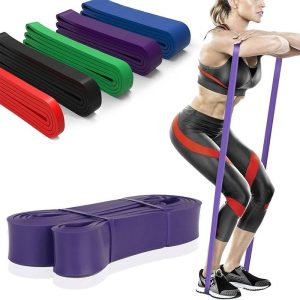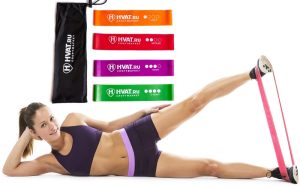What is a fitness elastic band
A fitness elastic band, also known as a resistance band or exercise band, is a flexible band made of latex or other materials that is used for strength training and stretching exercises. Fitness elastic bands come in various resistance levels, from light to heavy, and can be used for a wide range of exercises, including upper body, lower body, and core workouts.
Fitness elastic bands are a popular tool in fitness because they are lightweight, portable, and versatile. They can be used at home, at the gym, or on the go, and can be incorporated into many different workout routines. Some common exercises using fitness elastic bands include bicep curls, tricep extensions, squats, lunges, and leg lifts.
Fitness elastic bands can be purchased individually or in sets, and often come with instructions or workout routines to help users get started. They are a great addition to any fitness routine and can help increase strength, flexibility, and overall fitness level.
Efficiency of use
Fitness elastic bands are a highly efficient tool for exercise as they offer a range of benefits, including:
- Portability: Fitness elastic bands are lightweight and portable, making them easy to take with you wherever you go. They are ideal for people who travel frequently or don’t have access to a gym.
- Versatility: Fitness elastic bands can be used for a wide variety of exercises, including upper and lower body workouts, stretching, and rehabilitation exercises. This versatility allows for a full-body workout using just one piece of equipment.
- Low-impact: Fitness elastic bands are a low-impact exercise option, which means they are gentle on joints and muscles. This makes them a great choice for people who are recovering from an injury or have joint issues.
- Resistance training: Fitness elastic bands offer resistance training, which helps to increase strength, improve muscle tone, and enhance overall fitness level. Resistance training also promotes bone health and can help reduce the risk of injury.
- Cost-effective: Fitness elastic bands are an affordable exercise tool and are typically less expensive than other types of exercise equipment.
To maximize the efficiency of using a fitness elastic band, it’s important to choose the right resistance level for your fitness level and goals, use proper form during exercises, and gradually increase the intensity and frequency of workouts over time. It’s also important to use a variety of exercises to target different muscle groups and prevent boredom.

Advantages of elastic bands for fitness
Elastic bands, also known as resistance bands, offer a range of advantages for fitness training. Some of the key advantages include:
- Versatility: Elastic bands can be used for a wide variety of exercises, including upper and lower body workouts, stretching, and rehabilitation exercises. This versatility allows for a full-body workout using just one piece of equipment.
- Portability: Elastic bands are lightweight and portable, making them easy to take with you wherever you go. They are ideal for people who travel frequently or don’t have access to a gym.
- Low-impact: Elastic bands are a low-impact exercise option, which means they are gentle on joints and muscles. This makes them a great https://www.buydo.eu choice for people who are recovering from an injury or have joint issues.
- Adjustable resistance: Elastic bands come in different resistance levels, from light to heavy, allowing you to adjust the resistance to your fitness level and goals. This makes them suitable for beginners and advanced users alike.
- Cost-effective: Elastic bands are an affordable exercise tool and are typically less expensive than other types of exercise equipment.
- Improved muscle activation: Elastic bands provide resistance throughout the entire range of motion, which can help activate more muscle fibers and improve muscle activation compared to traditional weight training.
- Improved flexibility: Elastic bands can be used for stretching exercises, which can help improve flexibility and range of motion.
Overall, elastic bands are a versatile and effective tool for fitness training, providing a range of benefits for people of all fitness levels and goals.
Disadvantages of elastic bands for fitness
While elastic bands are generally a safe and effective tool for fitness training, there are some potential disadvantages to consider:
- Limited resistance: Elastic bands can provide a good amount of resistance, but they may not be as effective as traditional weight training for building maximal strength and muscle mass. Heavy bands may also be more difficult to use and require more skill and coordination.
- Durability: Elastic bands can wear out over time, especially with frequent use or exposure to heat and sunlight. They may also become less effective as they lose elasticity.
- Limited exercises: While elastic bands are versatile, they may not be suitable for all exercises or movements. Some exercises may be difficult to perform with elastic bands, or may require additional equipment to be effective.
- Safety concerns: Elastic bands can break or snap if they are worn or damaged, which can cause injury if not used correctly. It’s important to inspect bands for damage before each use and use proper form and technique during exercises.
- Limited progression: As you become stronger, you may need to purchase heavier bands to continue progressing, which can be an additional expense.
Despite these potential disadvantages, elastic bands can still be a valuable tool for fitness training and can offer many benefits for people of all fitness levels and goals. It’s important to use proper form and technique, inspect bands regularly for damage, and progress gradually to avoid injury and get the most out of your workouts.
Types of fitness elastic bands
Fitness elastic bands, also known as resistance bands or exercise bands, come in various types that differ in terms of their size, resistance level, and specific use. Some common types of fitness elastic bands include:
- Loop Bands: These are the most common type of fitness bands and are designed in a loop shape that can be stretched around different body parts. Loop bands come in different resistance levels and can be used for various exercises such as squats, lunges, and arm curls.
- Therapy Bands: These bands are similar to loop bands but are typically wider and have a lower resistance level. Therapy bands are often used in physical therapy and rehabilitation exercises to improve flexibility and strength.
- Figure-8 Bands: These bands are shaped like a figure 8 and can be used for a variety of exercises that require both upper and lower body movements.
- Tube Bands: These bands consist of a long tube with handles on each end, allowing for a wider range of exercises to be performed. They come in different resistance levels and can be used for strength training and toning.
- Flat Bands: These are flat, wide bands that are often used for stretching and warming up before exercise. They can also be used for resistance training and come in different resistance levels.
It’s important to choose the right type of band based on your fitness level and the specific exercises you plan to do. It’s also important to check the resistance level of the band before use and to gradually increase resistance as you become stronger.
How to choose the right fitness elastic bands
Choosing the right fitness elastic bands involves considering a few key factors, such as your fitness level, the specific exercises you want to do, and the resistance level of the band. Here are some tips to help you choose the right fitness elastic bands:
- Consider your fitness level: Fitness bands come in different resistance levels, so it’s important to choose a band that matches your fitness level. If you’re a beginner, you may want to start with a lighter resistance band and work your way up to heavier ones as you get stronger.
- Determine your goals: Think about the specific exercises you want to do and what you hope to achieve with the bands. Different types of bands are better suited for different exercises, so it’s important to choose the right one for your goals.
- Check the resistance level: Make sure you check the resistance level of the band before use, as this will determine how difficult it is to stretch. Bands typically come in different color codes to indicate resistance level, so be sure to choose the one that matches your fitness level and goals.
- Consider the type of band: There are different types of fitness bands, such as loop bands, therapy bands, figure-8 bands, tube bands, and flat bands. Each type has its own unique features and benefits, so choose the one that suits your needs.
- Look for quality: Choose a band made from high-quality materials that won’t easily snap or break during use. It’s also important to check the band for any signs of wear and tear before use to ensure it’s safe to use.
By taking these factors into consideration, you can choose the right fitness elastic bands to help you achieve your fitness goals.
What does color mean in fitness elastic bands?
In fitness elastic bands, color is often used as an indicator of the level of resistance or strength that the band provides. Different colored bands have different levels of resistance, with each color representing a different level of difficulty.
The exact color-coding system can vary between different brands or manufacturers, but it’s common to see a range of colors from light to dark or from low to high resistance. For example, a yellow band might be the lightest or easiest band to stretch, while a black band might be the heaviest or most difficult band to stretch.
Using different color bands can help people to progress through their exercises by gradually increasing the resistance as they become stronger. It can also make it easier to identify the right band for a particular exercise or level of fitness.
